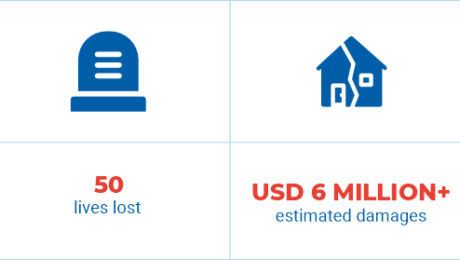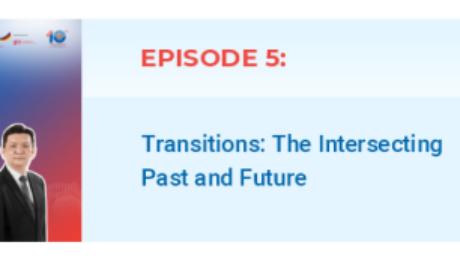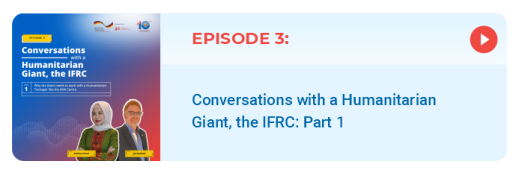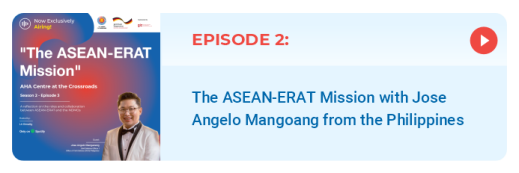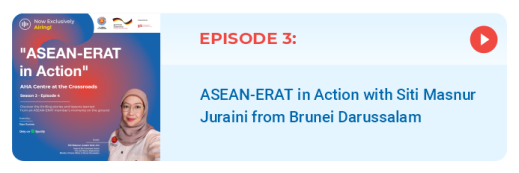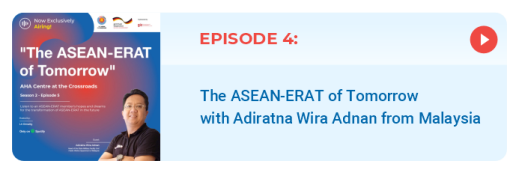Vol 85 – REMEMBERING TYPHOON MANGKHUT (OMPONG)

REMEMBERING TYPHOON
MANGKHUT (OMPONG)
On 15 September, Typhoon Mangkhut (locally known as Ompong) made landfall in Cagayan Province, the Philippines, unleashing devastating winds and torrential rains. In its wake, over 2.5 million people were affected, 50 lives lost, and hundreds injured. Homes, infrastructure, and livelihoods across eight provinces and seven cities/municipalities were severely affected. Typhoon Mangkhut, with a diameter surpassing that of 2013’s Typhoon Haiyan, caused damages estimated at over USD 6 million.
Pre-emptive actions by the Government of the Philippines, such as early evacuations and the provision of essential supplies played a large part in reducing the number of casualties and mitigating the disaster’s impact. The AHA Centre’s involvement was also instrumental, both in the preparation for and response to Typhoon Mangkhut. Working closely with the Philippines’ National Disaster Risk Reduction and Management Council (NDRRMC), the AHA Centre tracked the typhoon’s progress as it moved towards the Philippines.
An In-Country Liaison Team (ICLT) arrived in the Philippines hours after the typhoon’s landfall, standing by at the Emergency Operations Centre (EOC) of the NDRRMC to provide support to national relief efforts. Three ASEAN Emergency Response and Assessment Team (ASEAN-ERAT) Information Management Specialists were also deployed to support the NDRRMC with data analysis, data visualisation, and report writing.
The AHA Centre mobilised relief items worth over USD 275,000, including 30 tonnes of rice, four generator sets, and 2,000 rolls of tarpaulins, which were formally handed over to the NDRRMC in a meeting on 24 September 2018.
Five years later, the ASEAN response to Typhoon Mangkhut reminds us of the importance of preparedness, resilience, and unity in the face of calamities. ASEAN’s unified approach stands testament to the collective strength and solidarity of the ASEAN Member States in the spirit of “One ASEAN One Response.”

Written by: Gladys Respati | Photos by: AHA Centre
- Published in Insight
Vol 84 – GET TO KNOW ABOUT OPAK FAULT

GET TO KNOW ABOUT OPAK FAULT
Several geological studies have revealed that Southeast Asia is prone to earthquakes. This is inseparable from the fact that Southeast Asia is at the crossroads of three tectonic plates: the Pacific Ocean/Philippine Ocean Plate to the east, the Indo-Australian Plate to the south, and the Eurasian Plate to the northwest.
Opak Fault refers to a subsurface fault beneath the Opak River, 30 km southeast of Yogyakarta, and is covered by deposits of the young Mount Merapi, located in Bantul regency, southeast of Yogyakarta, within the southern Mount Merapi area. Early concerns about the existence of the Opak Fault arose when Dr. S. W. Visser reported an earthquake in Yogyakarta in 1867, with its epicenter located near the Opak River. It is also thought to have caused the formation of the Yogyakarta Basin, where the city of Yogyakarta is located.
The Opak Fault has an average depth of 55-82m, while its displacement ranges from 5-10m. Opak Fault is a normal fault that runs from southwest (SW) to northeast (NE); the west of the Opak Fault shows an uplift movement, while the east of the Opak Fault shows a subsidence movement. The fault runs through the Yogya Lowlands and the Wonosari Plateau, with old andesite rocks (OAF) as structural elements. This fault system also includes the Semilir Formation and the Nglanggran Formation to the east of Opak.
There is a significant surface deformation along the Opak Fault, which could be driven by the postseismic effect following the 2006 Yogyakarta earthquake or by aseismic creep. This long-term surface deformation can also affect various aspects of earthquake-affected land, including infrastructure and environmental damage.
The earthquake in Yogyakarta on 27 May 2006 was one of the worst disasters experienced by the people of Yogyakarta and Indonesia. Over 5,700 people were killed, 37,927 were injured, 240,396 homes were destroyed, and local infrastructure and economic activities were severely affected.
Located in the southern part of Java, Yogyakarta is prone to experiencing moderate to high-magnitude earthquakes (M > 6.0) with return periods of 50–100 years, making it one of Indonesia’s most seismically active cities. Of the 12 earthquakes in Yogyakarta from 1804-2006, three earthquakes, including the 2006 earthquake, were related to the movement of the Opak fault.
More recently, on 30 June 2023, Yogyakarta was hit by an earthquake measuring 5.8 (USGS) or 6.4 on the magnitude scale, although it only caused minor damage. This could also be attributed to the public’s preparedness and the strong structural integrity of buildings – lessons learned following the 2006 earthquake.
The position of the fault plane that cuts through the soil layer with a thickness of about 50 cm – 5 m indicates that this fault is active. Furthermore, the Opak Fault, which is still active, is increasingly showing signs of increased seismic activity based on BMKG monitoring. Communities around the Opak Fault often feel small earthquakes, or what they call “lindu”.
In addition, several areas traversed by the Opak Fault have high liquefaction potential. This is due to the geological environment in the form of alluvium deposits, groundwater table conditions, the path of the active Opak fault zone, and the Bantul basin (Bantul Graben).
Sustainable and resilient countermeasures are needed to deal with various potential disasters in a region historically prone to earthquake disasters, both in Yogyakarta and Southeast Asia. Therefore, the scenario of a 6.6 magnitude earthquake caused by the Opak Fault for the 2023 ASEAN REGIONAL DISASTER SIMULATION EXERCISE (ARDEX) offers a valuable opportunity for local and regional humanitarian actors to prepare for and respond to such a scenario, enhancing their readiness to mitigate the impact of such disasters effectively. The AHA Centre is pleased to participate in ARDEX-23, the ASEAN region’s biggest disaster and emergency response simulation exercise.
Sources
• BBC News Indonesia. (2023, August 5). BMKG Ingatkan Bahaya Sesar Opak, Warga Hanya Bisa Pasrah. kumparan. https://kumparan.com/bbc-news-indonesia/bmkg-ingatkan-bahaya-sesar-opak-warga-hanya-bisa-pasrah-20viEi4cfz3
• Cahyani, E., Afrita, W. N., Aza, A. E. N., & Sumunar, D. R. S. (2019). Pengembangan sistem jaringan evakuasi bencana likuifaksi di wilayah Sesar Opak. Geo Media: Majalah Ilmiah dan Informasi Kegeografian, 0(1).
• Dewanto, B. G., Setiawan, M. B., & Nusantara, G. C. (2020). Opak Fault Deformation Monitoring Using Sentinel-1 InSAR Data from 2016-2019 in Yogyakarta Indonesia. Elipsoida: Jurnal Geodesi dan Geomatika, 0(01), 46-54.
• Fathonah, I. M., Wibowo, N. B., & Sumardi, Y. (2014). Identifikasi Jalur Sesar Opak Berdasarkan Analisis Data Anomali Medan Magnet dan Geologi Regional Yogyakarta. Indonesian Journal Of Applied Physics, 0(02), 192-200.
• Prihatmaji, Y. P., Kitamori, A., & Komatsu, K. (2014). Traditional javanese wooden houses (Joglo) damaged by may 2006 Yogyakarta earthquake, Indonesia. International Journal of Architectural Heritage, 0(2), 247-268.
• Shah, A. A., Qadri, T., & Khwaja, S. (2018). Living with earthquake hazards in South and South East Asia. ASEAN Journal of Community Engagement, 2(1), 2.
• Sihombing, T. (2014). Perkembangan Elemen-Elemen Penting Tektonik Asia. Jurnal Geologi dan Sumberdaya Mineral, 4(2), 63-68.
• Sumartiningtyas, H. K. N. (2023, August 5). Mengenal Sesar Opak, Pusat GEMPA Yogyakarta 2006 halaman all. KOMPAS.com. https://www.kompas.com/sains/read/2023/08/05/093000323/mengenal-sesar-opak-pusat-gempa-yogyakarta-2006?page=all
• Sutiono, A., Prastistho, B., & Prasetyadi, C. (2018, December). Opak fault: a comparative review. In IOP Conference Series: Earth and Environmental Science (Vol. 212, No. 1, p. 012049). IOP Publishing.
• Pena-Castellnou, S., Steinritz, V., Marliyani, G. I., & Reicherter, K. (2021, October). Active tectonics of the Yogyakarta area (Central Java, Indonesia): preliminary findings obtained from a tectonic-geomorphic evaluation. In IOP Conference Series: Earth and Environmental Science (Vol. 851, No. 1, p. 012005). IOP Publishing.
• Prasetiyo, W. (2023, August 5). Lebih Jauh Soal Sesar Opak Dan potensi GEMPA Kuat di Yogyakarta. kumparan. https://kumparan.com/kumparannews/lebih-jauh-soal-sesar-opak-dan-potensi-gempa-kuat-di-yogyakarta-20vgpHD6DMJ
• Wijaksono, E. (2008). Pemodelan Tiga Dimensi (3D) Zona Sesar Opak Bantul Yogyakarta Berdasarkan Data Anomali Bouguer Lengkap.
Written by: M. Nadhif Achyansyah
- Published in Insight
Vol 82 – AHA CENTRE PODCAST SERIES: AT THE CROSSROADS

AHA CENTRE PODCAST SERIES:
AT THE CROSSROADS
The AHA Centre, with support from Deutsche Gesellschaft für Internationale Zusammenarbeit GmbH (GIZ), worked to broaden its communications and outreach, including on social media. One of the results of this cooperation was a series of podcasts released in mid-2021 as part of the AHA Centre’s 10th Anniversary celebration. The podcast series entitled “AHA Centre at the Crossroads” involved discussions with the AHA Centre’s founders, builders, colleagues and partners, and discussed the AHA Centre’s 10-year journey from inception to transition. The guests described their experiences in working together with the Centre and expressed their hopes for the future in the next decade of action.
The first season is already airing and accessible at the AHA Centre’s Spotify channel – AHA Centre at the Crossroads. Meanwhile, the second season focused on sharing experiences from members of the ASEAN Emergency Response and Assessment Team (ASEAN-ERAT) as ASEAN’s rapid response team and was released in February 2023.
In the second season, four ASEAN-ERAT members from Thailand, Philippines, Brunei Darussalam, and Malaysia shared their experiences of becoming ASEAN-ERAT members, particularly when the were deployed to the disaster affected countries. Being deployed to different countries has always been a challenge for them. Not only conducting rapid needs assessment in the affected areas, but the ASEAN-ERAT members also need to understand the culture and other social aspects.
The AHA Centre Podcast has become an alternative channel for the AHA Centre to communicate to its partners and stakeholders on various topics in this digital era.
SEASON 1
SEASON 2
Written by: Moch Syifa
- Published in Insight
Vol 79 – GENDER AND WOMEN’S ROLES IN DISASTER MANAGEMENT

GENDER AND WOMEN’S ROLES
IN DISASTER MANAGEMENT
When typhoons, earthquakes, volcanic eruptions and other natural disasters happen, it does not choose between age, class, race or gender. Everyone is affected. Lives are lost, properties are destroyed and communities displaced. But what many do not know is that disasters affect men, women, boys and girls in different ways with women and girls being the most vulnerable group. Consequently, the fatality rate is higher for women than men.
When the 2004 tsunami struck Indonesia, India and Sri Lanka, four times as many women than men lost their lives. One reason for this was more men learned to swim and climb trees at an early age than women. During the 1991 cyclone hit Bangladesh, 90% of the victims were women between the ages of 20-49 years because their mobility was restricted due to cultural norms. As more men were at work, women were left at home when the disaster struck. Research showed that they chose to stay to protect their properties, while some prioritized the rescue of children and the elderly.
There were reports that one woman chose to stay behind in the recent volcanic eruption of Mt. Semeru in Indonesia. The woman chose to stay at home with her elderly family member instead of getting evacuated, which cost both their lives.
More and more stories like these are being reported and it highlights the gender inequality that takes place during disasters.
Socio-economic backgrounds, cultural norms and traditions are some of the reasons why women are most vulnerable during disaster management and emergencies. In developing countries, there are less opportunities for women to get education and employment. There are also more male leaders in humanitarian organization and disaster management organizations which affects planning and policy making.
The needs of men, women, boys and girls differ across class and age as do their resources and coping strategies. An example is relief efforts at one evacuation center for victims of Mt. Semeru’s eruption. Women voiced out their need for underwear since they cannot wash clothes and the need for diapers for babies.
Studies show too that during disaster emergencies, incidents of gender-based violence against women increase. It is estimated that “1 in 5 refugee or displaced women in complex humanitarian settings have experienced sexual violence.” The psychological and emotional effect on people get heightened during disasters and women often become victims of the violence.
But progress has been made in recent years to address the gender inequality. In the massive earthquake in Mexico, women formed groups and led rescue and relief efforts which hastened the recovery process. In Nepal, foreign-funded projects helped set-up women’s cooperatives to help communities get back on their feet after the big earthquake.
Developed countries are not spared gender inequalities in humanitarian response. Japan has been rocked by powerful earthquakes in the past and this has highlighted the need to recognize and protect women’s rights during disasters. Incidents of gender-based violence rise during emergencies. One report says that a woman got raped after the earthquake and reported this to the local authorities, who in turn said that she should be considerate as the man who perpetuated this was also dealing with the trauma post-earthquake. To make disaster management for gender sensitive, the Japan government sent all their local governments notification to include the needs of women and children in disaster response planning.
Disaster management needs to be gender-sensitive especially on the most vulnerable group. Gender equality needs to be recognized as early as the planning stage so that the needs of everyone are met and more lives are saved. The more gender sensitive humanitarian efforts are in light of disaster management and risk reduction, the more resilient and stronger a society will be.
Sources:
https://blogs.worldbank.org/sustainablecities/why-we-need-integrate-gender-equality-and-women-s-empowerment-disaster-recovery-and-how-do-it
*https://www.unicef.org/media/67346/file/The-material-risks-of-gender-based-violence-in-emergency-settings-2020.pdf
https://en.antaranews.com/news/203489/semeru-eruption-ministry-seeks-to-meet-needs-of-women-children
Written by : Judith Garcia Meese
- Published in Insight
Vol 77 – SOCIAL MEDIA IN DISASTER MANAGEMENT

SOCIAL MEDIA
IN DISASTER MANAGEMENT
Social media plays an increasingly important role in disaster management. Some would even argue that it has played a vital role in recent years, with lives saved and much needed food, water and supplies delivered to where they are needed most.
While major news media companies provide ample coverage when a disaster occurs anywhere in the world, information gets posted and exchanged at a much faster pace on social media. Text, pictures and videos get published at lightning speed and often make it to TV, even if they are not of the usual broadcast quality.
A case in point is the earthquake that devastated Haiti in 2010 when 2,000 posts on Twitter, Facebook and other social media proved critical in guiding rescue efforts.
When an earthquake struck the island of Lombok in Indonesia, social media was key in bringing help to the villages that were affected most. Many of the pictures and videos of the devastation posted on Instagram were also helpful in raising funds.
There is also the “Safety Check” feature that Facebook has added. More and more people now use it to tell their social media network that they are safe and unharmed. It has already been used by 9 million people in the United States when hurricanes have struck.
Celebrities have been known to turn to social media for fund-raising, appealing to their fan base. US celebrity James Woods used his Twitter account during the fires that ravaged California in 2019. Woods used Twitter to post reports and updates that resulted in several people being reunited with their loved ones.
As ordinary people become journalists, a lot of information gets shared and published. Disasters get reported as they happen. And with this wealth of information, which is posted more often in real-time, rescue organisations and agencies are able use this to map out relief efforts.
While there is the freedom of sharing information, there is also the issue of authenticity and credibility. “Fake news” has now proliferated to the extent that a lot of rescue groups treat social media posts with caution. Other posts can be misleading too. A picture of one flooded street cannot give you the overall situation in a community. But while this has become an issue, it still cannot be denied that social media plays a significant role in disseminating information and bringing aid to where it is much needed.
Source:
https://www.preventionweb.net/news/how-social-media-shaping-disaster-governance
https://www.telegraph.co.uk/technology/information-age/how-social-media-can-help-during-crisis/
https://preparecenter.org/topic/social-media-disasters/
Written by : Judith Garcia Meese
- Published in Insight
Vol 74 – WHY HELIX IS NOT A SUCCESS (YET)

WHY HELIX IS NOT A SUCCESS (YET)
The name HELiX was a year in the making. And the event itself had a much longer history. Gaynor Tanyang, the DELSA Programme Coordinator, is here to share the story.
HELiX, or the Humanitarian and Emergency Logistics Innovation Expo, is a component of the Disaster Emergency Logistics System of ASEAN (DELSA) project, which is one of the AHA Centre’s oldest-running projects. In 2018, DELSA Phase II was approved, which has three components: the establishment of DELSA satellite warehouses in the Philippines and Thailand; capacity building; and innovation.
Planning for HELiX started in 2019 with three cogs: problem identification; sharing and recognising innovative approaches; and the development of concrete action plans from National Disaster Management Organisations (NDMOs).
In March 2020, my colleague Ms. Caroline Widagdo and myself met with our country host, Viet Nam, travelling to Hanoi on an almost empty plane, face masks on. We excitedly planned for a big physical event in conjunction with the commemoration of Viet Nam’s National Day of Disaster Prevention and Control in May 2020. HELiX was also going to be one of the flagship events of Viet Nam’s ASEAN chairmanship. As the cases of COVID-19 grew in number globally and in the region, the co-organisers agreed to push back the staging of HELiX to 2021, with a prayerful optimism that the event could be held physically onsite.
Meanwhile, the DELSA team got busy digging for examples of logistics innovations that could be applied in the humanitarian context and found a myriad of them. We had insightful discussions with partners, old friends and industry experts to understand how they defined “innovation”. We sought their views about the trends and challenges in the supply chain and what ASEAN could do to improve humanitarian logistics. In a parallel process, the United States Agency for International Development (USAID) supported research on logistics-capacity needs assessment in ASEAN. Meanwhile, Ms. Agustina (Rina) Tnunay, our internal authority on logistics was busy asking the NDMOs in ASEAN what the future of DELSA should look like.
All of these initiatives became part of the “problem definition” that influenced the design of HELiX. Thinking time was on our hands, the DELSA team was emboldened to take on a complex conference design that had simultaneous sessions, a hackathon, a pitching competition and an exhibition. We wanted the conference experience itself to look, hear and feel innovative. But 2020 drew to a close with all of us still working from home. The situation still felt very volatile and uncertain.
The decision to go ahead with HELiX in a fully online mode was agreed in mid-February. We set-up the virtual conference infrastructure with the support of Mr. Risdianto Irawan, our internal tech buff. We introduced the idea of HELiX to everyone we could reach by email.
We had HELiX meetings back-to-back – with partners and their partners – and we were invigorated that they, too, were excited about the idea. And the event itself had a very fruitful outcome – both in numbers and in substance. We even met our target with regard to our competition prizes threefold! Winners got a chance to visit Singapore, receive mentoring from financial investment experts and cash prizes! And many will agree, they saw, they heard and they felt innovative at some point being part of the HELiX experience.
SO WHY DO I SAY THAT HELIX IS NOT A SUCCESS (YET)?
Problem identification? Check. Sharing and recognising innovative solutions? Check. Developing a concrete action plan by ASEAN Member States? In progress.
When I was leading the visioning and planning of HELiX, I had in mind that the outcomes of HELiX would feed into the new phase of the ASEAN Humanitarian Logistics Roadmap. This would seal the trifecta of HELiX success.
And while planning HELiX, I could hear Co-Chair of the Preparedness, Response, and Recovery Working Group (PRRWG) Mr. Abdul Razak’s voice in my head saying, “HELiX should address the challenges of ASEAN Member States in humanitarian logistics.”
So, here is where we are. We celebrate the bonds and networks that flourished during HELiX. We cheer the indomitable spirit of the AHA Centre staff who provided an unforgettable virtual experience in a time of COVID-19.
But we have only begun our baby steps. The real seal of success for HELiX is to see, hear and feel the visible and tangible innovative solutions at work in the 10 ASEAN Member States. Who knows? Our Donation Matching App by Padayon, could be ASEAN’s platform for humanitarian giving.
And then, there’s still AHACKATHON.
Written by : Gaynor Tanyang
- Published in Insight
Vol 72 – AS LOCAL AS POSSIBLE: STUDY ON LOCALISATION OF DISASTER MANAGEMENT DURING PANDEMIC AS LOCAL AS POSSIBLE

AS LOCAL AS POSSIBLE
STUDY ON LOCALISATION OF DISASTER MANAGEMENT DURING PANDEMIC
Localisation is an international process involving the empowerment of local actors in humanitarian assistance. At the 2016 World Humanitarian Summit, leaders declared that humanitarian action should be “as local as possible, as international as necessary.” This definition highlighted the disparities among international humanitarian actors, UN agencies, international non-governmental organisations and local humanitarian actors in disaster management. Since there is no universal definition, stakeholders debate the different interpretations of localisation. Drawing from the insights of key informants, the following working concept of localisation was used:
Localisation is a process of recognizing, respecting and strengthening the independence of leadership and decision-making of local actors in humanitarian and disaster response. Local actors include national actors, sub-national actors, local authorities, local communities and local civil society organisations.
In order to better understand how localisation is perceived in the region, the AHA Centre collaborated in research with the School of International and Public Affairs (SIPA) at Columbia University and the Center for Excellence in Disaster Management and Humanitarian Assistance (CFE-DM) based in Hawaii. This required stakeholder analysis to (i) determine how localisation evolved, particularly since the beginning of the COVID-19 pandemic, (ii) define the role of the AHA Centre in operationalising local efforts and analysing sustainable methodologies and (iii) reflecting on adaptations of the broader Southeast Asian humanitarian system.
The research, through qualitative interviews and quantitative surveys, explored the perspectives of key stakeholders in the humanitarian sector. These informants and respondents included ASEAN Member States and other governmental bodies, donors, international organisations, including the United Nations (UN) and non-UN affiliated, local, national and non-governmental organisations, national societies and other community partners. The surveys and the interviews were conducted between February and March 2021, while the final report was completed in April 2021.
The definition of localisation depends significantly on each organisation’s scope and scale of engagement. Respondents from international organisations deemed national organisations as local, while national organisations deemed actors at the sub-national and community levels as local. They also recognised capacity-building as the most integral dimension of localisation, thus emphasising the importance of empowering local actors through laws, training and knowledge sharing, among other aspects.
Survey respondents cited the AHA Centre as having an essential role in coordination and providing visibility to regional and national actors. Interviewees and respondents expressed the belief that the AHA Centre was helpful in capacity-building, coordination, partnership and in furthering support for these localisation dimensions. Many survey respondents also agreed that regional organisations were essential in furthering local-led responses.
The research also produced several strategic recommendations for ASEAN and the AHA Centre to improve localisation, including:
▸ Creating a leadership programme for civil society organisations (CSOs);
▸ Allocating specific staff for CSO engagement;
▸ Monitoring and evaluating CSO engagement through robust indicators;
▸ Providing visibility platforms for local CSOs;
▸ Using local resources to overcome language barriers; and
▸ Communicating with locals in real time during disasters
The COVID-19 pandemic has brought the urgency of localisation to the fore. The pandemic has severely impacted personnel mobility within countries and between countries. Due to the prevailing restrictions, international organisations’ personnel often cannot help affected areas. As such, adaptation plans have been drawn up to address the impact of COVID-19, including operational modality and geographical areas of implementation to alleviate the personnel and logistical restrictions.
Respondents felt that COVID-19 either hampered or accelerated the process of localisation. A respondent from an international organisation mentioned how COVID-19 had put its capacity-building efforts for local actors on hold due to a lack of internet connectivity in certain communities and the inability to train in person. Governments also had to rely on local organisations, instead of external support. Leaders resorted to activating local organisations from the affected regions to prevent the spread of the disease.
In conclusion, the study highlights the complexities of, as well as opportunities for, localisation in the region during the pandemic. There is an increased recognition among the actors of the importance of localisation. Of all the different perspectives that were presented on localisation, the research found that almost all respondents could at least agree on one thing: humanitarian action should be “as locals as possible, as international as necessary.”
Written by : Daniel Boey, Sarah Hussain, Chennan Jin, Alexis R. Moore, Nopasi Niyamabha, Fariha Wasti, and Mark James Wood – Columbia University – School of International and Public Affairs
- Published in Insight
Vol 71 – TRAVEL CORRIDOR ARRANGEMENTS: BETWEEN ECONOMIC AND HEALTH INTERESTS

TRAVEL CORRIDOR ARRANGEMENTS:
BETWEEN ECONOMIC AND HEALTH INTERESTS
An article by the AHA Centre’s own Grace Endina – a preparedness and response officer in the ASEAN Emergency Response and Assessment Team (ASEAN-ERAT) – was recently published on the Jakarta Post’s website. Named Travel corridor arrangements: Between economic and health interests, this article provides an insight into travel during the time of pandemic, and highlights areas for learning that could be utilised during this or future pandemics. The following are excerpts from Grace’s article, with the full version linked at the end of the text.
I am one of the few people who were fortunate to be able to travel amid the pandemic, flying from Jakarta to Yangon, Myanmar. Indeed, it was really challenging even before I hopped on the flight in my mask and face shield, and with my handy bottle of hand sanitizer. Thanks to the pandemic, I had to transit in Singapore and then Malaysia, due to the different procedures in each country. These included the validity period of COVID-19 test results, flight availability, sudden visa requirements and transit restrictions for passengers arriving from certain cities.
At Yangon International Airport, airport authorities and officers from the Ministry of Health strictly recorded passengers’ data and then transported them via a shuttle service to a designated quarantine hotel. Foreigners were taken to one hotel, where we were required to self-quarantine for exactly two weeks. Another interesting observation was the rather long time that passed between arriving flights at the three airports, which I guess was intended to enable airport authorities and health officials to manage and control the arrival of international travelers.
The most interesting aspect was the quarantine process and period. While some studies have suggested that the coronavirus may not be detected in the early days of exposure, each country applied different quarantine periods and different swab testing frequencies and intervals for travelers. Singapore and Myanmar, for instance, imposed a very strict quarantine period of 14 days and required two polymerase chain reaction (PCR) tests. Once you exit the immigration counters in these countries, you are transported on a bus to the designated quarantine hotel, accompanied by airport authorities. The airport authorities have already booked your hotel for the quarantine period, so you have no options to stay at different hotel. The quarantine hotels are not open to regular guests. Meanwhile, in Indonesia, the quarantine period is currently five days with two PCR tests. As soon as you exit the airport, salespeople from designated quarantine hotels and designated taxi companies offer their services to arriving travelers who do not have bookings yet.
My experience traveling during COVID-19 showed that each country has adopted different arrival procedures and quarantine protocols. I guess this depends mainly on the availability of their resources and interests in view of restoring essential business services. While it is clear that the generally prescribed quarantine period is 14 days, there is no prescribed method for how best to manage airports amid the pandemic. The health sector advises travelers to quarantine for 14 days without taking an immediate swab test, but others may think differently in terms of issues of practicality rather than what should be done from the perspective of public health. With these different standards for travel corridor arrangements, is it possible to protect business interests and public health at the same time?
Written by : Grace Endina
- Published in Insight
Vol 70 – UTILISING VIRTUAL AND AUGMENTED REALITY FOR TRAINING EXERCISES AND FIELD-BASED EMERGENCY OPERATIONS

UTILISING VIRTUAL AND AUGMENTED REALITY
FOR TRAINING EXERCISES AND FIELD-BASED EMERGENCY OPERATIONS
Responding to a disaster during the emergency situation is not a simple process. It requires multi-level coordination, multidisciplinary experts, and an array of other resources. Therefore, well-trained human resources for disaster management and emergency response are imperative. Virtual and Augmented Reality holds significant potential to be utilised as a platform for training disaster management actors, particularly in this current pandemic situation. Not only this, but such technology shows significant potential for utilisation in certain aspects of field-based emergency response as well.
According to Kumaran, et al. (2007), in the article Augmented Reality Applications in Disaster Management, for post-disaster relief activities to return to normal, we require multidisplinary experts, stakeholders, and layers of coordination for preparing rescue and recovery plans. This process sometimes takes time, and can cause conditions to become worse. Thus, well-planned actions are key to rescue affected people, and also to reduce the number of casualties.
In order to address the issue of complexity in coordination process, it is suggested that Virtual and Augment Reality technology applications be utilised for training in disaster management as well as in the field during emergency response.
For training, Virtual and Augmented Reality is an effective way to make learning process easier and more efficient. In an emergency response, Virtual and Augmented Reality can help visualise the effects of calamities, by providing increased time to experts for making alternative plans. The technology also helps disaster management actors and stakeholders better plan actions during an emergency situation. By having well-planned structure and actions, the relief work can take place immediately after disaster strikes.
However, there are challenges in developing and implementing Virtual and Augmented Reality in disaster management and emergency response. The main challenge is the cost of the technology, and also limitations for implementing on a wider scale. Those challenges aside, some experts believe that Virtual and Augmented Reality in disaster management – especially in the training process for disaster management actors – can still have advantages.
THE ADVANTAGES OF VIRTUAL AND AUGMENTED REALITY
IN DISASTER MANAGEMENT TRAINING PROCESS
First, this technology is safer for training as it reduces interactions and dangers faced in the field.
Second, it provides more comprehensive experiences for participants, and provides more realistic disaster scenarios.
Third, although the technology itself is costly, training using Virtual and Augmented Reality is cost effective, as participants and trainers are not required to physically visit certain locations.
Finally, the technology also makes the learning process more visual, and can provide an almost-real experience.
Written by : Moch Syifa
- Published in Insight
Vol 69 – SOCIAL MEDIA IN DISASTER MANAGEMENT

SOCIAL MEDIA
IN DISASTER MANAGEMENT
The Southeast Asian region has the third largest, and the most active, social media users in the world, as stated in We Are Social and Hootsuite’s Digital Report 2021. Countries like Indonesia, the Philippines, Thailand and Viet Nam can be found in the top ten Facebook nations across the world. Such data confirms that social media forms a significant part of Southeast Asian daily life, as residents turn to social media for many reasons, and in particular to obtain information.
When disaster strikes, social media becomes one of the key outlets for public information access. Depending on the type and scale of a disaster, most people have limited access to other information outlets such as television or radio. However, as social media applications are available on most mobile phones and can work with a limited phone plan, they often form the only information source available during and directly after a disaster.
HUMANITARIAN ORGANISATIONS CAN STRATEGICALLY UTILISE SOCIAL MEDIA TO CONVEY MESSAGES IN EACH PHASE OF A DISASTER
1. MITIGATION
Firstly, in the mitigation phase, social media can help disseminate messages and engage public in discussion about disaster and development issues within the community. With the right social media analytics, a humanitarian organisation can identify target sections of an audience within the wider community on social media. Some mitigation messages on social media could be delivered to sections of the community who are not impacted when a disaster occurs, while mapping vulnerable communities, sending them messages directly via social media, and involving them in the conversation forms a more effective option.
2. PREPAREDNESS
Secondly, in the preparedness phase, social media can facilitate messages to educate the general public on how to respond and recover from a disaster. Social media tools such as multimedia, interactivity, and narrowcast make it an ideal place for educational videos and infographics, or even a strong short message to promote what to do when disaster occurs. Social media users tend to remember and would likely share strong hashtags or educational entertainment videos within their social networks. In this phase, it is also important to integrate social media messages with other outlets, or integrate social media messages from different stakeholders.
3 RESPONSE
Third, in the response phase, social media has played a significant role as an immediate information outlet. This is the phase where information floods through social media, including messages to report a disaster, details to understand the impact of a disaster, and communication to look for missing family members or to seek help. In this phase, a well-trained social media specialist who understands social network analysis can help map the crisis based on social media posts. This skill is important to understand not only the spread of information during a disaster, but also to identify the impacted communities and their needs. Mapping out communities on social media can also help estimate assistance and aid they require, as well as the allocation of support effectively. In this phase, data visualisation may work best compared to other forms of communication.
4. RECOVERY
During the recovery phase social media can facilitate messages related to government assistance, fundraising and donations from global audiences, as well as the recovery plan. Research on the usage of social media and smartphone apps by Zhang et. Al. (2014) in China during a major air pollution crisis showed that people also go to social media to look for physical and psychological well-being support. In coping with stress and loss because of disaster, victims use social media as a place to look for emotional support from their social network,s or support from communities and humanitarian organisations.
To strategically plan social media educational campaigns or crisis communication during a disaster, humanitarian organisations need to understand several aspects of social media.
- First of all, audiences in each country have their own preferred social media platforms and behaviour. This is important to understand before selecting a social media platform and creating messages.
- Second, each social media platform has its own unique features that can support different types of messages. Some platforms are more suitable for educational messages, but other platforms may be better for facilitating awareness and response.
- Last but not least, a different phase of disaster has a different range of time to respond. Humanitarian organisations must establish standard operational procedures for their social media communication strategy, especially during the response phase.
Written by : Ika K. Idris, PhD
Ika K. Idris is the Director of Research of Paramadina Public Policy Institute/PPPI at Universitas Paramadina, Jakarta. She specialises in social media analytics and public communication.
- Published in Insight

